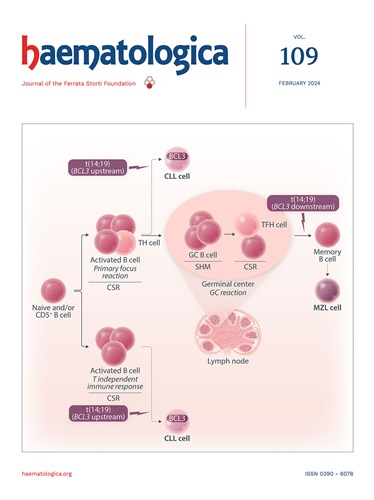小GTPase ARF6调节鞘脂稳态并支持急性髓性白血病的增殖。
IF 7.9
1区 医学
Q1 HEMATOLOGY
引用次数: 0
摘要
代谢依赖性正在成为包括急性髓性白血病(AML)在内的癌症的有希望的治疗靶点。在AML细胞中发现了几种代谢脆弱性,包括需要平衡鞘脂代谢来维持生存和增殖。在这里,我们描述了RAS超家族小GTPase ARF6在维持AML鞘脂稳态中的新功能。ARF6基因缺失抑制AML细胞系的增殖,减少原代AML CD34+细胞的集落形成。从机制上讲,ARF6通过提高鞘磷脂合成酶(SGMS1/2)表达促进神经酰胺向鞘磷脂的转化,从而阻止细胞毒性神经酰胺水平的积累。因此,在两个独立的AML队列中,AML患者细胞中ARF6及其效应物SGMS1/2的高表达与较短的生存期相关,ARF6表现出与欧洲白血病净遗传风险无关的不良预后影响。ARF6小分子抑制剂抑制原发AML CD34+细胞的集落形成,但不抑制脐带血CD34+细胞,并在异种移植模型中显示出活性。AML细胞依赖ARF6调节鞘脂稳态可能提供治疗机会。本文章由计算机程序翻译,如有差异,请以英文原文为准。
The small GTPase ARF6 regulates sphingolipid homeostasis and supports proliferation in acute myeloid leukemia.
Metabolic dependencies are emerging as promising therapy targets in cancer, including acute myeloid leukemia (AML). Several metabolic vulnerabilities have been identified in AML cells, including a requirement for balanced sphingolipid metabolism to maintain survival and proliferation. Here we describe a novel function of the RAS superfamily small GTPase ARF6 in maintaining sphingolipid homeostasis in AML. Genetic depletion of ARF6 inhibited the proliferation of AML cell lines and reduced colony formation of primary AML CD34+ cells. Mechanistically, ARF6 promotes conversion of ceramide to sphingomyelin by enhancing sphingomyelin synthase (SGMS1/2) expression, thereby preventing accumulation of cytotoxic ceramide levels. Accordingly, higher expression of ARF6 and its effectors SGMS1/2 in AML patient cells correlates with shorter survival in two independent AML cohorts, with ARF6 exhibiting an adverse prognostic effect independent of European Leukemia Net genetic risk. Small molecule inhibitors of ARF6 suppressed colony formation by primary AML CD34+ cells, but not cord blood CD34+ cells and showed activity in xenograft models. The dependency of AML cells on ARF6 to regulate sphingolipid homeostasis may present a therapeutic opportunity.
求助全文
通过发布文献求助,成功后即可免费获取论文全文。
去求助
来源期刊

Haematologica
医学-血液学
CiteScore
14.10
自引率
2.00%
发文量
349
审稿时长
3-6 weeks
期刊介绍:
Haematologica is a journal that publishes articles within the broad field of hematology. It reports on novel findings in basic, clinical, and translational research.
Scope:
The scope of the journal includes reporting novel research results that:
Have a significant impact on understanding normal hematology or the development of hematological diseases.
Are likely to bring important changes to the diagnosis or treatment of hematological diseases.
 求助内容:
求助内容: 应助结果提醒方式:
应助结果提醒方式:


